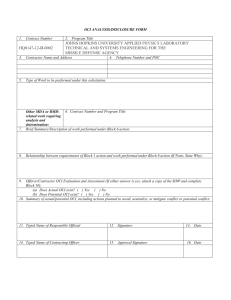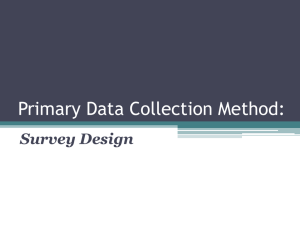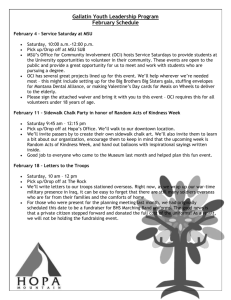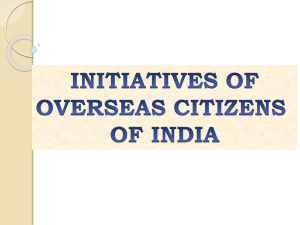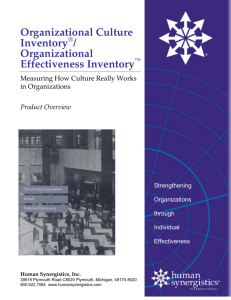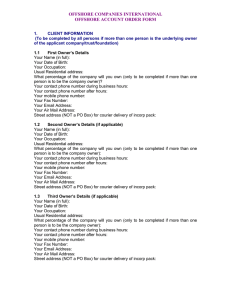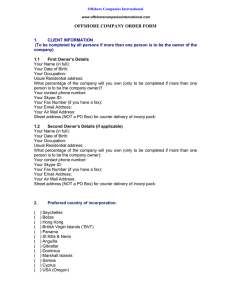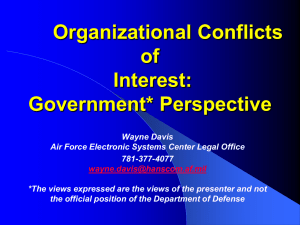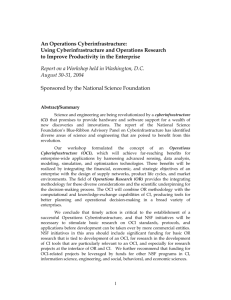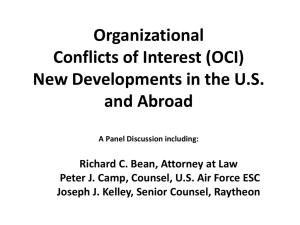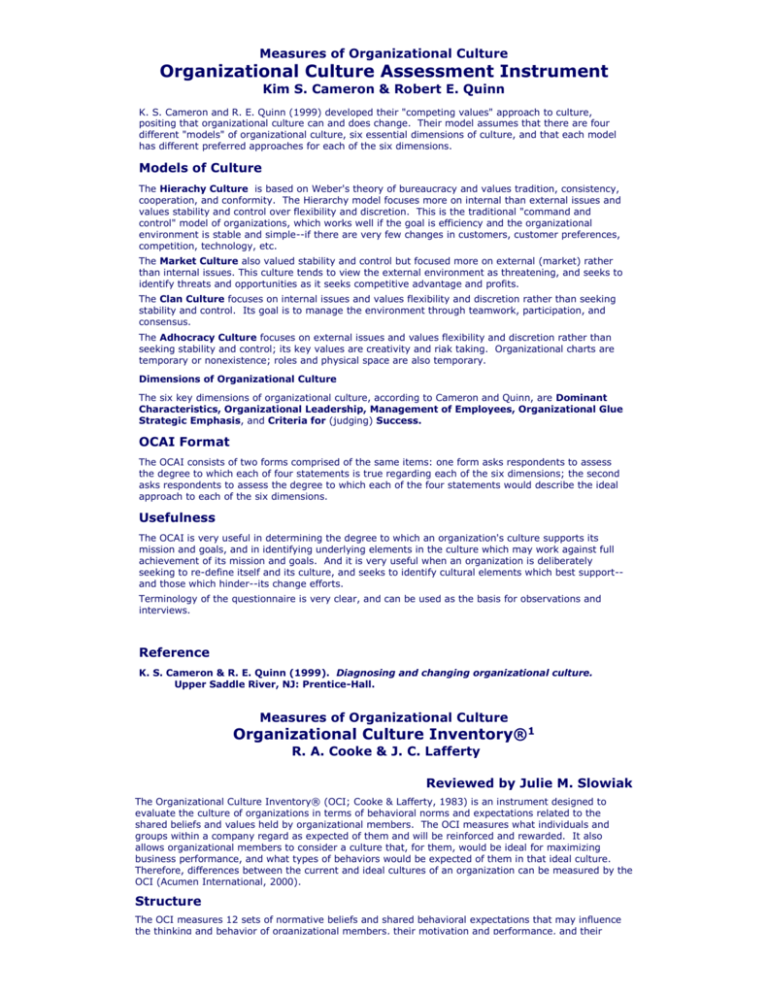
Measures of Organizational Culture
Organizational Culture Assessment Instrument
Kim S. Cameron & Robert E. Quinn
K. S. Cameron and R. E. Quinn (1999) developed their "competing values" approach to culture,
positing that organizational culture can and does change. Their model assumes that there are four
different "models" of organizational culture, six essential dimensions of culture, and that each model
has different preferred approaches for each of the six dimensions.
Models of Culture
The Hierachy Culture is based on Weber's theory of bureaucracy and values tradition, consistency,
cooperation, and conformity. The Hierarchy model focuses more on internal than external issues and
values stability and control over flexibility and discretion. This is the traditional "command and
control" model of organizations, which works well if the goal is efficiency and the organizational
environment is stable and simple--if there are very few changes in customers, customer preferences,
competition, technology, etc.
The Market Culture also valued stability and control but focused more on external (market) rather
than internal issues. This culture tends to view the external environment as threatening, and seeks to
identify threats and opportunities as it seeks competitive advantage and profits.
The Clan Culture focuses on internal issues and values flexibility and discretion rather than seeking
stability and control. Its goal is to manage the environment through teamwork, participation, and
consensus.
The Adhocracy Culture focuses on external issues and values flexibility and discretion rather than
seeking stability and control; its key values are creativity and riak taking. Organizational charts are
temporary or nonexistence; roles and physical space are also temporary.
Dimensions of Organizational Culture
The six key dimensions of organizational culture, according to Cameron and Quinn, are Dominant
Characteristics, Organizational Leadership, Management of Employees, Organizational Glue
Strategic Emphasis, and Criteria for (judging) Success.
OCAI Format
The OCAI consists of two forms comprised of the same items: one form asks respondents to assess
the degree to which each of four statements is true regarding each of the six dimensions; the second
asks respondents to assess the degree to which each of the four statements would describe the ideal
approach to each of the six dimensions.
Usefulness
The OCAI is very useful in determining the degree to which an organization's culture supports its
mission and goals, and in identifying underlying elements in the culture which may work against full
achievement of its mission and goals. And it is very useful when an organization is deliberately
seeking to re-define itself and its culture, and seeks to identify cultural elements which best support-and those which hinder--its change efforts.
Terminology of the questionnaire is very clear, and can be used as the basis for observations and
interviews.
Reference
K. S. Cameron & R. E. Quinn (1999). Diagnosing and changing organizational culture.
Upper Saddle River, NJ: Prentice-Hall.
Measures of Organizational Culture
Organizational Culture Inventory®1
R. A. Cooke & J. C. Lafferty
Reviewed by Julie M. Slowiak
The Organizational Culture Inventory® (OCI; Cooke & Lafferty, 1983) is an instrument designed to
evaluate the culture of organizations in terms of behavioral norms and expectations related to the
shared beliefs and values held by organizational members. The OCI measures what individuals and
groups within a company regard as expected of them and will be reinforced and rewarded. It also
allows organizational members to consider a culture that, for them, would be ideal for maximizing
business performance, and what types of behaviors would be expected of them in that ideal culture.
Therefore, differences between the current and ideal cultures of an organization can be measured by the
OCI (Acumen International, 2000).
Structure
The OCI measures 12 sets of normative beliefs and shared behavioral expectations that may influence
the thinking and behavior of organizational members, their motivation and performance, and their
satisfaction and stress. Normative beliefs are defined as “cognitions held by an individual regarding
others’ expectations for his behavior as a member of a particular group or organization.” Shared
behavioral expectations are “those normative beliefs that are held in common by members of a group or
organization” (Cooke & Szumal, 1993).
These 12 sets of normative beliefs and shared behavioral expectations refer to 12 different cultural
styles that are placed around a circumplex, with their proximity reflecting their expected degree of
association (see Figure 1; Cooke & Rousseau, 1988; Acumen International, 2000; Cooke & Szumal,
2000; Szumal, 2003). The 12 Styles are2:
Humanistic-Encouraging: Members are expected to be supportive, constructive, and open
to influence in their dealings with one another.
Affiliative: Members are expected to be friendly, cooperative, and sensitive to the
satisfaction of their work group
Approval: Members are expected to be friendly, cooperative, and sensitive to the
satisfaction of their work group.
Conventional: Members are expected to conform, follow the rules and make a good
impression.
Dependent: Members are expected to do what they’re told and clear all decisions with
superiors
Avoidance: Members are expected to shift responsibilities to others and avoid any possibility
of being blamed for a problem.
Oppositional: Members are expected to be critical, oppose the ideas of others, and make
safe (but ineffectual) decisions.
Power: Members are expected to take charge, control subordinates, and yield to the
demands of superiors.
Competitive: Members are expected to operate in a “win-lose” framework, out-perform
others, and work against (rather than with) their peers.
Perfectionistic: Members are expected to appear competent, keep track of everything, and
work long hours to attain narrowly-defined objectives.
Achievement: Members are expected to set challenging but realistic goals, establish plans
to reach those goals, and pursue them with enthusiasm.
Self-Actualizing: Members are expected to enjoy their work, develop themselves, and take
on new and interesting tasks.
The 12 types of norms and expectations are associated with and organized into three general
types of cultures (Acumen International, 2000). They are:
Constructive - members are encouraged to interact with people and approach tasks in
ways that will help them to meet their higher order satisfaction needs
Passive-Defensive - members believe that they must interact with people in ways
that will not threaten their own security
Aggressive-Defensive - members are expected to approach tasks in forceful ways to
protect their status and security
The OCI can be administered in a group setting or on an individual basis. There are two versions of the
OCI: a computer-scored and hand-scored version. Both the computer-scored and hand-scored versions
have 120 items. Each of the 12 styles is measured by 10 items describing behaviors that might be
expected or required by members of an organization. The items are ranked on a 5-point Likert scale
ranging from 1 (“not at all”) to 5 (“to a very great extent”), indicating the level at which the behavior
helps people to “fit in” and “meet expectations” in their organization (Cooke & Rousseau, 1988).
Results are plotted on the Human Synergistics® Circumplex (Human Synergistics, 2000), which can
show either a person’s individual normative beliefs (when the viewpoint of only one person is plotted) or
the shared behavioral expectations that function within the organization (when the viewpoints of
different people are combined).
As stated earlier, the OCI can be used to measure both the current and ideal organizational cultures.
When assessing current culture, the OCI includes items intended to evaluate business outcomes related
to the organization’s culture. Results provide information about the need and direction for cultural
change and potential business results that can come from culture change efforts. By contrast, when
assessing ideal culture, the OCI includes items designed to measure the participants’ readiness for
moving the current culture toward the ideal. Results identify possible sources of support as well as
resistance to cultural change efforts. These results will also project further benefits which organizational
members feel will result from cultural change.
Strengths and Weaknesses
The OCI has been researched extensively and is continually evaluated to ensure that its assessments
are reliable and consistent over time and across raters (Acumen International, 2000). No recent
documentation on the reliability and validity of this instrument was found; however, Cooke and
Szumal’s (1993) research tested three types of reliability – internal consistency, interrater, and testretest – and two types of validity – construct and criterion-related – on data provided by 4,890
respondents from three versions of the OCI. Cronbach’s alpha coefficients support the internal
consistency of each of the 12 scales, ranging from .65 to .95. Analysis of interrater agreement found
that reliability was high across the three forms and variance in responses was explained by
organizational membership. Test-retest reliability was found to show the stability of scale scores over
time. The results of a factor analysis of the construct and criterion-related validities of the OCI showed
support across the three forms.
Cooke and Szumal (1993) suggest a possible weakness of the OCI in regard to its discriminant validity.
It has been found that certain scales (i.e., Conventional, Avoidance, Oppositional, Perfectionistic) show
dual loadings on one or more forms. Dual loadings refer to the overlap of a particular style on two of
the three general types of culture. The researchers state that this may be due to a weakness of the
OCI, or it could suggest that the norms for the general culture styles are loosely linked in certain
settings.
Applications
The OCI is an instrument that can be used in any organizational setting and has many applications.
According to Human Synergistics (2000), the OCI is “the most widely used and thoroughly researched
tool for measuring organizational culture in the world.” The OCI can be used for many things including:
identifying areas where change is needed, developing a vision for cultural changes, evaluating the
effects of organizational change efforts, and managing diversity and international relations. Therefore,
the OCI is a general instrument that can be tailored to meet the needs o almost any organization.
References
Acumen International. (2000). Organizational assessment: Organizational culture inventory. Retrieved
October 7, 2002, from http://www.acumen.com/?!=products_oa_oci
Cooke, R. A., & Szumal, J. L. (1993). Measuring normative beliefs and shared behavioral expectations in
organizations: The reliability and validity of the organizational culture inventory. Psychological Reports,
72(3), 1299-1330.
Cooke, R.A. & Szumal, J.L. (2000). Using the organizational culture inventory to understand the
operating cultures of organizations. In N.M. Ashkanasy, C.P.M. Wilderom, & M.F. Peterson (Eds.),
Handbook of organizational culture and climate. Thousand Oaks, CA: Sage Publications.
Cooke, R. A., & Rousseau, D. M. (1988). Behavioral norms and expectations: A quantitative approach to
the assessment of organizational culture. Group & Organization Studies, 13(3), 245-273.
Cooke, R. A., & Lafferty, J. C. (1983). Level V: Organizational Culture Inventory (Form I). Plymouth, MI:
Human Synergistics.
Human Synergistics. (2000). Organizational culture inventory (OCI). Retrieved October 7, 2002, from
http://www.hscar.com/oci.htm
Szumal, J.L. (2003). Organizational Culture Inventory Interpretation and Development Guide. Plymouth,
MI: Human Synergistics International
Footnotes
1Organizational
Culture Inventory® is a registered trademark of Human Synergistics International,
Plymouth, MI USA. All Rights Reserved. Used by permission.
All OCI style descriptions: Research and Development by Robert A. Cooke, Ph.D. and J. Clayton
Lafferty, Ph.D. Copyright 1973-2007 by Human Synergistics International. Reproduced by permission.
2
Measures of Organizational Culture
Organizational Culture Instrument
W. T. van de Post, Y. J. de Coning, et al.
Reviewed by Shelley A. Berg
Compiled by W. van der Post and T. de Coning at the University of Stellenbosch’s Graduate
School of Business in 1997, this instrument was created with the aim of evaluating the major
elements of an organization’s culture. While the instrument’s results are not intended to assign
an organization to a specific culture type, such as the Organizational Assessment Culture
Instrument, it does provide insight to the norms and attitudes of an organization’s members on
the 15 elements examined in the questionnaire.
Structure
While the questionnaire used in the early trials of the survey consisted of 225 questions and took
respondents approximately 30 minutes to complete, the final version only includes 97 questions,
requiring about 15 minutes for completion. Similarly, despite the fact that Post and Coning’s
literature review in preparation of this questionnaire identified 114 dimensions of culture, the
assistance of human resource experts narrowed that number down to the 15 that are actually
included in the questionnaire. The 15 dimensions measured in the final questionnaire are listed
below:
Culture management
The extent to which the organization actively and deliberately engages in shaping the
organization's culture
Customer orientation
The extent to which the organization takes the views of customers seriously and
actively responds to such views
Disposition towards change
The degree to which employees are encouraged to be creative and innovative and to
constantly search for better ways of getting the job done
Employee participation
The extent to which employees perceive themselves as participating in the decisionmaking process of the organization
Goal clarity
The degree to which the organization creates clear objectives and performance
expectations
Human resource orientation
The extent to which the organization is perceived as having a high regard for its human
resource
Identification with the organization
The degree to which employees are encouraged to identify with the organization
Locus of authority
The degree of authority, freedom and independence that individual employees have in
their jobs
Management style
The degree to which managers provide clear communication, assistance and support to
their subordinates
Organization focus
The extent to which the organization is perceived to be concentrating on those
activities which form part of the fundamentals of the business
Organization integration
The degree to which various subunits within the organization are actively encouraged to
operate in a coordinated way by co-operating effectively towards the achievement of
overall organizational objectives
Performance orientation
The extent to which emphasis is placed on individual accountability for clearly defined
results and a high level of performance
Reward orientation
The degree to which reward allocations are based on employee performance in
contrast to seniority, favoritism or any other non-performance criterion
Task structure
The degree to which rules, regulations, and direct supervision are applied to manage
employee behavior
Each item on the questionnaire is in the form of a positive or negative statement, which is rated
on a seven-point Likert scale by the respondent according to its application to his/her perceptions
of the organization being rated. In scoring the questionnaire, scores for the positive statements
are added together along with the inverse scores of the negative statements, producing an
overall total for each dimension.
Strengths, Weaknesses, and Application
In terms of strengths, the questionnaire has scored high in both reliability and validity. Each of
the 15 dimensions included in the survey has a reliability coefficient alpha above the generally
accepted minimum of .7, ranging from .788 to .932. Post and Coning also reported an acceptable
level of construct validity upon conducting a factor analysis.
Weaknesses of Post and Coning’s organizational culture instrument are not directly discussed.
One shortcoming that may be considered, however, is a lack of interpretation for the
questionnaire’s scores. Although patterns among the responses for individual items clarify the
manner in which an organization is perceived, the numerical scores resulting from individual
dimensions provide little insight.
Weaknesses of Post and Coning’s organizational culture instrument are not directly discussed.
One shortcoming that may be considered, however, is a lack of interpretation for the
questionnaire’s scores. Although patterns among the responses for individual items clarify the
manner in which an organization is perceived, the numerical scores resulting from individual
dimensions provide little insight.
Weaknesses of Post and Coning’s organizational culture instrument are not directly discussed.
One shortcoming that may be considered, however, is a lack of interpretation for the
questionnaire’s scores. Although patterns among the responses for individual items clarify the
manner in which an organization is perceived, the numerical scores resulting from individual
dimensions provide little insight.
Measures of Organizational Culture
Organizational Culture Profile
C. A. O'Reilly, J. Chatman, and D. E. Caldwell
The Organizational Culture Profile (OCP) was developed by O'Reilly, Chatman, and Caldwell (1991) to
calculate person-organization fit, Respondents who are familiar with the organization are given cards
with 54 statements reflecting individual and/or organizational values and asked to sort them into each of
nine categories, based on the degree to which the statements are characteristic of the organization
studied.
Analysts of individual responses to the OCP found that 27 of the items loaded on seven dimensions.
Three dimensions related to how work is handled: detail, stability, and innovation. Two dimensions,
team orientation and respect for people, describe values or norms for interpersonal relationships. Two
additional dimensions describe norms for individual actions: outcome orientation and aggressiveness.
The 54 OCP items are listed in the appendix the the primary references, listed below.
A 40-item version of the OCP was used by Cable and Judge (1997).
Reliability
The reliability for the ratings of the organization's values obtained with OCP is assessed using the
Spearman-Brown prophecy formula. Reliability ranged from .84 to .94 five published studies.
Primary Reference
O'Reilly, C. A.; Chatman, J. A.; & Caldwell, D. F. (1991). People and organizational culture: A profile
comparison approach to person-organization fit. Academy of Management Journal, 34(3), 487-516.
Additional References
Cable, D. M.; Aiman-Smith, L.; Mulvey, P, W.; & Edwards, J. R. (2000). The sources and accuracy of
job applicants’ beliefs about organizational culture. Academy of Management Journal 43(6), 1076-1086.
Cable, D. M. & Judge, T. A. (1997). Interviewers' perceptions of person-organization fit and
organizational selection decisions. Journal of Applied Psychology, 82, 5460581.
o
Caldwell, D. F.; Chatman, J. A.; & O'Reilly, C. A. (1990). Building organizational commitment: A multifirm study. Journal of Occupational & Organizational Psychology, 63, 245-251.
Caldwell, D. F., & O'Reilly, C. A.(1990). Measuring person-job fit with a profile-comparison process.
Journal of Applied Psychology, 75, 648-657.
Chatman, J. A. (1989). Improving interactional organizational research: A model of person-organization
fit. Academy of Management Review, 14 (3), 333-349.
Chatman, J. A. & Jehn, K. A. (1994). Assessing the relationship between industry characteristics and
organizational culture: How different can you be> Academy of Management Journal, 37(3), 522-553.
Erdogan, Berrin; Kraimer, Maria L.; Liden, Robert C. (1992). Person-organization fit and work attitudes:
The moderating role of Leader-Member Exchange. Academy of Management Proceedings, F1-F6
Sheridan, J. E. (1992). Organizational culture and employee retention. Academy of Management
Journal, 35(5), 1036-1056.
Vandenberghe, C. (1999). Organizational culture. person-culture fit, and turnover: A replication in the
health care industry. Journal of Organizational Behavior, 20, 175-184
Measures of Organizational Culture
Organizational Culture Survey
S. R. Glaser, S. Zamanou, and K. Hacker
Reviewed by Maria Falcone
The concept being measured in this section is organizational culture. Organizational culture in
this context refers to shared meanings, patterns of belief, symbols, rituals and myths that evolve
over time, which function as the glue that holds the organization together. It can also be referred
to as shared expectations for consensually approved behavior. Culture research focuses variously
on the symbolic aspects of organizational life, myths, stories, legends and on socialization and
rites of passage.
Structure
The instrument discussed in this section is known as the Organizational Culture Survey (OCS). It
is a standardized survey questionnaire. You can add a triangulation approach with the use of the
OCS by employing reliably coded interviews along with the survey. These critical incident
interviews help to interpret and place the results of the statistical analyses in context.
The OCS can be used to examine six components of organizational culture, grounded in both
management and communication research. They include; teamwork-conflict, climate-morale,
information flow, involvement, supervision and meetings. These six categories can be studied
with the OCS and are helpful because they are central to any construction of organizational
culture; around which rituals develop and stories evolve.
The original version of the OCS was a 62-item questionnaire with five subscales; climate,
involvement, communication, supervision, and meetings. Initially employees were asked to
describe what it was like to work in their organization and were urged to explain their perceptions
through stories. Questionnaires were administered to every organizational member and were
filled out in scheduled locations at scheduled times. By doing this, it eliminated the problems of
poor return rate and sampling error, which provides a strength for this instrument. This also
helps to increase the instrument's reliability. Items in each of the five subscales were subjected
to a standard set of interim reliability and internal consistency analyses. The revised
questionnaire had 31 items because items were deleted if they were predictable by the other
items of the subscale. One main weakness of this tool is that it may not be as beneficial used by
itself. The article describes how it was able to make a more thorough evaluation by incorporating
an interviewing process.
In order to assess test-retest reliability of the OCS, the full instrument was administered to 35 of
the 52 subjects who agreed to participate in this phase of the research. These specific subjects
provided information about their birthday and the maiden name of their mother, which allowed
the test and retest data to be matched while preserving the anonymity of research participants.
Application
Before researchers can approach the questions of whether organizational culture can be managed
or whether strong cultures contribute to or reduce organizational performance, a methodology
must be developed. The methodology can be developed to enable the researcher to empirically
establish what an organization's culture is at a particular point in time.
An example of what can emerge from the analyses of OCS scores is showing how an organization
may have dissatisfied employees at all but the top management level. It may also show that
employees are experiencing low morale and are dissatisfied with their organization's level of
teamwork, information flow, supervision and involvement. These characteristics help researchers
define an organization's culture and how to improve or change it to create a better atmosphere
for all employees.
Involvement of some subjects in critical incident interviews will help elicit their interpretations of
organizational events and help give a better understanding of the culture.
Original Source
Glaser, S. R., Zamanou, S., & Hacker, K. (1987). Measuring and interpreting organizational
culture. Management Communication Quarterly, 1(2), 173-198.

